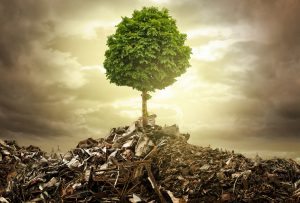by KenBay | Dec 18, 2018
Challenge: Reduce the cost of hauling waste to the nearest Waste to Energy facility to make the process cost effective.
Solution: Use the RotoPac with its high compaction ratio to package the waste into 4’ cubes for cost effective transport.
Result: Making the process of hauling waste that here-to- for could not be cost effectively transported long distances to a Waste to Energy facility for incinerating it into energy bricks.
by LaurenL | Oct 13, 2016
 For many businesses, a common barrier to recycling is a lack of resources. For businesses that handle recyclable cans, PET bottles, or cartons, depackaging equipment can help. While there are depackaging companies that can handle this task for you, many businesses now opt to complete the simple process themselves. Typically, these types of containers are not recycled because, in order to do so, they must first be rinsed of their liquid waste. A depackaging machine can do this task for you, while also benefiting your recycling efforts in other surprising ways. Here’s how.
For many businesses, a common barrier to recycling is a lack of resources. For businesses that handle recyclable cans, PET bottles, or cartons, depackaging equipment can help. While there are depackaging companies that can handle this task for you, many businesses now opt to complete the simple process themselves. Typically, these types of containers are not recycled because, in order to do so, they must first be rinsed of their liquid waste. A depackaging machine can do this task for you, while also benefiting your recycling efforts in other surprising ways. Here’s how.
1. No Pre-Cleaning Required
Depackaging is an integral part of waste management processes for zero waste businesses in the food industry. Thanks to this technology, they can easily separate recyclable containers from the food waste that may be inside. Food depackaging equipment varies, but popular models either unscrew bottles, or perforate cans, cartons, and bottles and then rinse whatever liquid is contained inside. This is particularly good for depackaging milk, yogurt, soft drinks, BBQ sauces and ketchup, ice cream, liquid soaps and detergents, and more.
Often, precleaning keeps people from recycling. However, with the right depackaging equipment, you can simply throw full containers into the machine. These containers are perforated or unscrewed by the machine. Then, the depackaging equipment works its magic. Food waste and other liquids inside containers are removed.
2. Recyclable Material is More Easily Managed
Not only does depackaging save you time that would otherwise be devoted to emptying containers of their waste, it can also save you money in your pursuit of zero waste. The best depackaging systems also have compaction chambers. After your containers are perforated and emptied, they are shredded or compressed tightly. With depackaging equipment that also has a high compaction rate, you’ll be able to load more recyclable waste on a single truck and make fewer trips to recycling centers or Waste to Energy plants. Because of this, you’ll spend less money on managing your recyclable waste.
3. Non-recyclable Items Can Be Repurposed
A little-known fact: depackaging equipment can also help businesses manage non-recyclable items like styrofoam or other similar materials. If your business is often left with EPS Polystyrene fish boxes and packaging, EPS dust, polypropylene packaging and insulation foam, or polypropylene (EPP) packaging, depackaging equipment can help you manage this waste. Like recyclables, these items can be emptied of any waste they may hold.Then, the foam that is left over can be condensed to create large blocks of foam. These blocks can then be sold, creating a new revenue stream for your business.
Integrate Depackaging Into Your Waste Management Process with KenBay!
If you think your waste management process could benefit from depackaging, let KenBay help you find the perfect equipment to get the job done. Our SC 2000 and SC 3000 Screw Compactors are configured for depackaging, dewatering or foam densifying. If you want to make your facility landfill free, these screw compactors can be an integral part of your waste management system. Low maintenance and heavy-duty, a KenBay screw compactor is capable of handling large throughputs of material while still maintaining a high compaction rate continuously throughout the operation.
We know that waste management can be a burden. But, with KenBay, you’ll have the tools you need to help make the job a little easier. The next time you evaluate your waste products and waste management strategy, consider integrating one of our industrial trash compactors into your processes.
Because our depackaging trash compactors will reduce the weight and size of your recyclable waste, they are a great way to cut down your waste removal costs and improve the efficiency of waste management.
Don’t let something like waste get in the way of your business operations. If you’re interested in learning more about depackaging or finding a committed consultant to help you reduce your waste, call KenBay. We can tell you more about our services, no matter what industry you’re in, or how much waste you are creating!
Photo credit: Getty Images / photka
by charlotte | Aug 6, 2016
 The waste to energy debate in the United States has been a tense one as environmentalists and politicians weigh many aspects of a solution that hasn’t yet caught on. With municipal landfills getting zoned off in most major cities nationwide, there is certainly a need for new waste management streams, and we have a moral obligation to stop sending it to third world countries whose infrastructures can’t handle it. Though a zero landfill initiative would be a dream come true for the government and environmentalists alike, there isn’t hope of this becoming a reality anytime soon, necessitating accessible alternatives like an investment in more waste to energy plants.
The waste to energy debate in the United States has been a tense one as environmentalists and politicians weigh many aspects of a solution that hasn’t yet caught on. With municipal landfills getting zoned off in most major cities nationwide, there is certainly a need for new waste management streams, and we have a moral obligation to stop sending it to third world countries whose infrastructures can’t handle it. Though a zero landfill initiative would be a dream come true for the government and environmentalists alike, there isn’t hope of this becoming a reality anytime soon, necessitating accessible alternatives like an investment in more waste to energy plants.
What is the Waste to Energy Debate?
Waste to Energy, or WtE, is a means of disposing of waste, usually by incineration, to produce electricity and heat, and even biofuels. There are less than 100 WtE plants in the United States, while in Europe it has become much more popular and is accepted there as a form of renewable energy. American environmentalists would argue that it can’t be renewable if it depends on human waste. Many WtE plants can sell energy or heat directly to the grid, while the combustible fuel producers create methane, methanol, ethanol or synthetic fuels that can be used for transportation as well as in industry. Aside from the debate as to whether waste to energy is actually a renewable energy stream, many people use the Not-in-my-Backyard (NIMBY) argument against building more WtE plants because they are worried about smells, smoke, and other pollutants. These concerns have been largely disproven through research, however.
The Cost of Transportation
There is the question of the cost associated with shipping waste to WtE plants and whether it’s worth the transportation costs. The fact is that many municipalities are already increasing their waste transportation costs because of full landfills, and are sending their garbage not only to other states but to other countries. The rising costs of shipping waste are significant and becoming the norm in more densely population centers around the country.
Is it Worth Shipping to a Waste to Energy Plant?
It may seem an unnecessary cost to ship to a WtE plant right now, but the more mainstream this solution becomes, the more plants will be built. By fronting the cost now, you are investing in the future of waste management in this country. The hope is that someday you will have a municipal waste to energy plant that won’t require excessive shipping costs. There are numerous ways to reduce the amount of waste you are producing, as well as the option of investing in a commercial trash compactor. Both scenarios will help offset some of the costs of shipping your waste to a WtE.
If you are considering whether to do more with your waste then send it to your local landfill, the waste to energy solution is a great opportunity for you. If you want to speak with waste management experts to discuss your options, give KenBay a call!



 The
The 